This document discusses various boundary layer control techniques applied to compressor rotor blades to enhance their efficiency and mitigate flow separation. It evaluates three specific methods: suction, blowing, and a combination of both, through numerical simulations using ANSYS CFX. The study highlights the importance of rotor blade geometry and how effective boundary layer control can lead to improvements in pressure ratios and overall compressor performance in transonic aircraft engines.
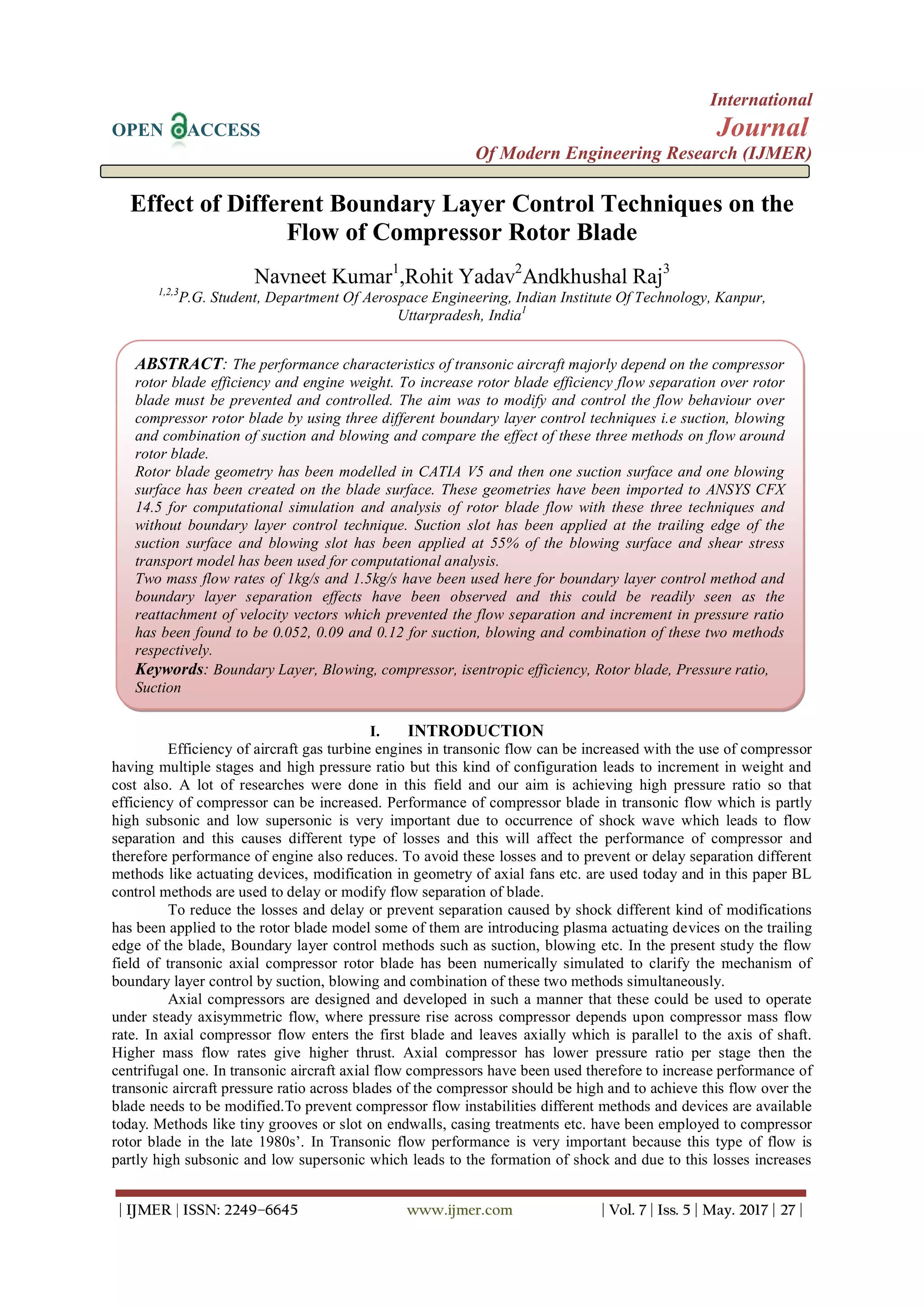
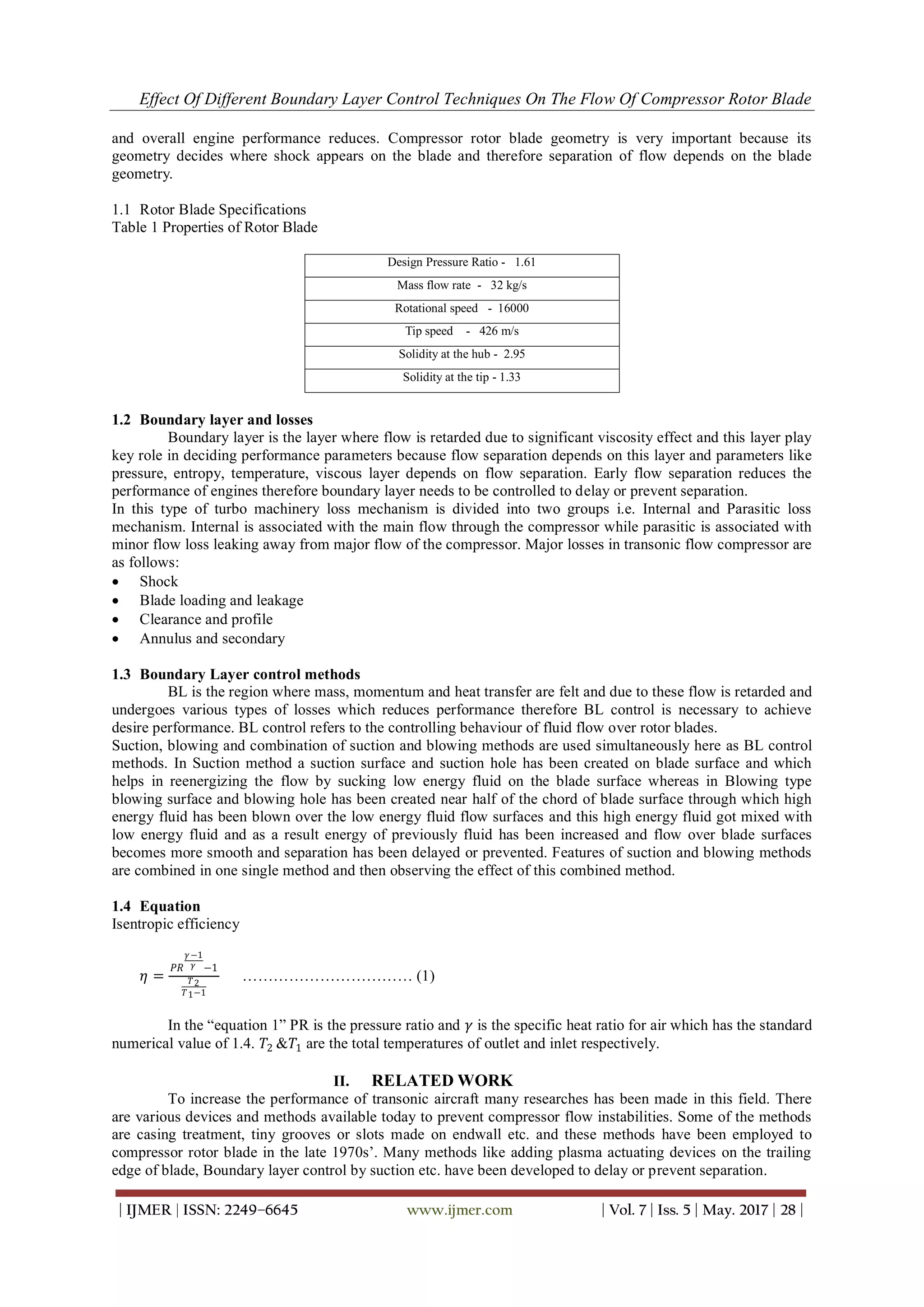
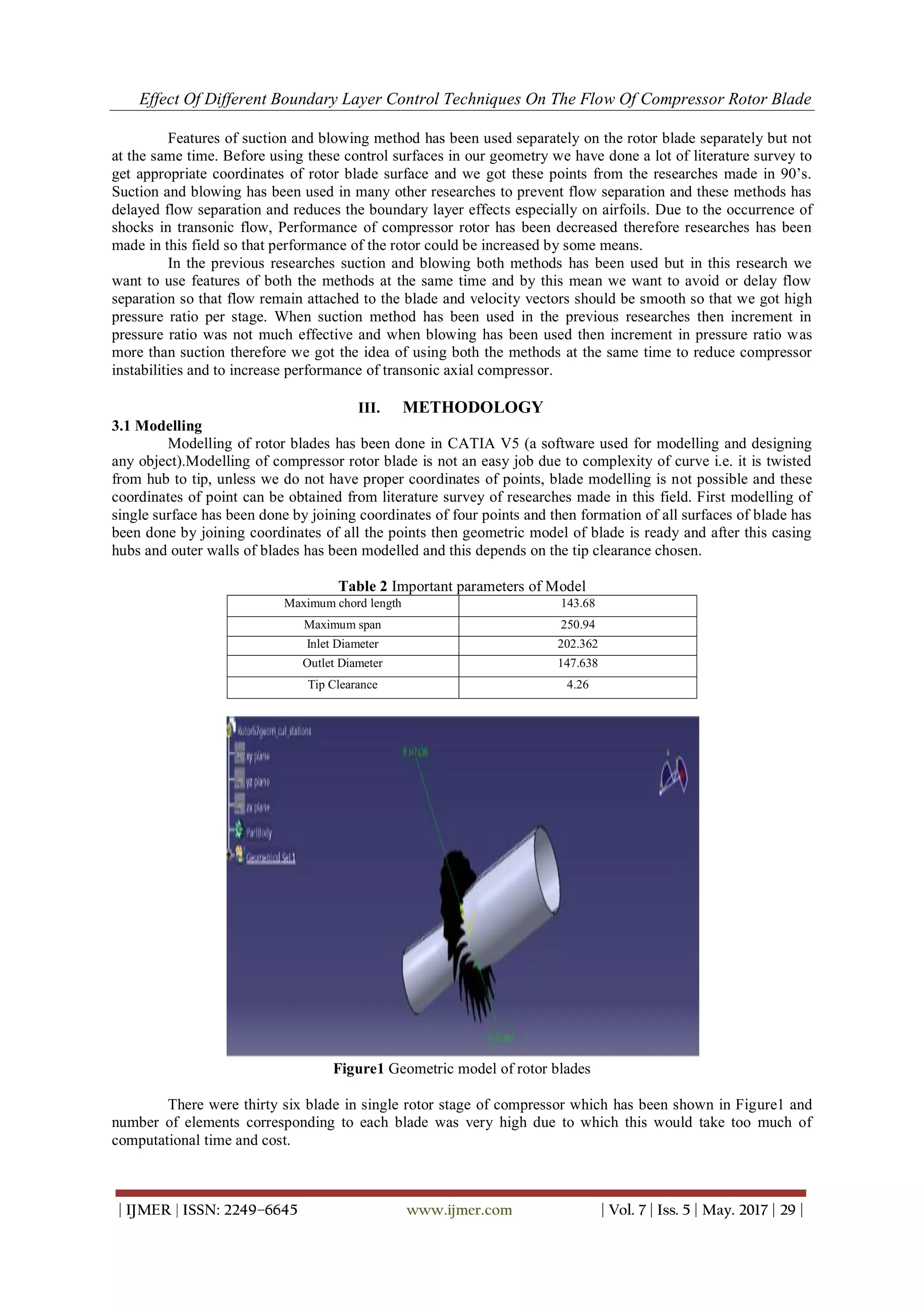
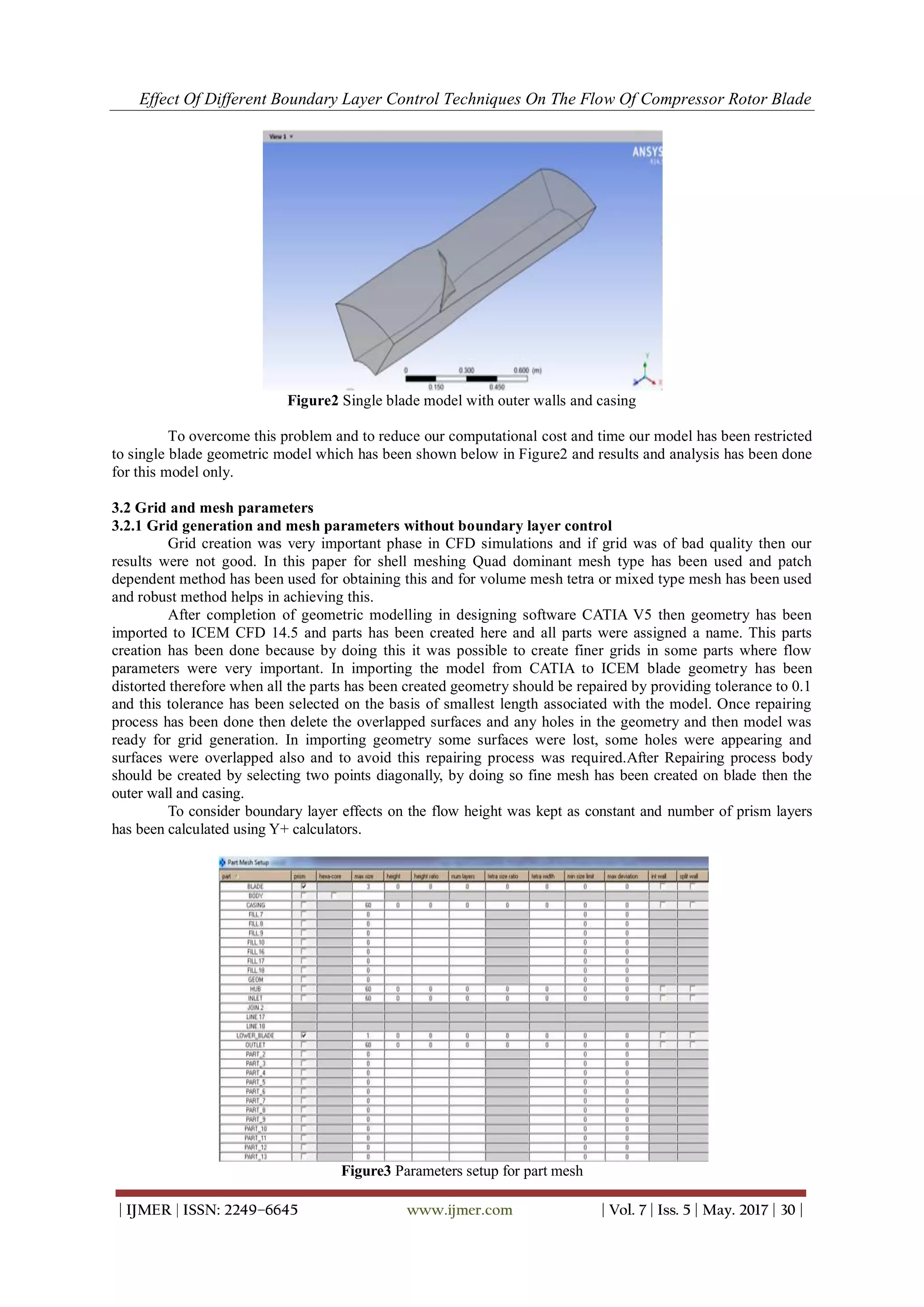
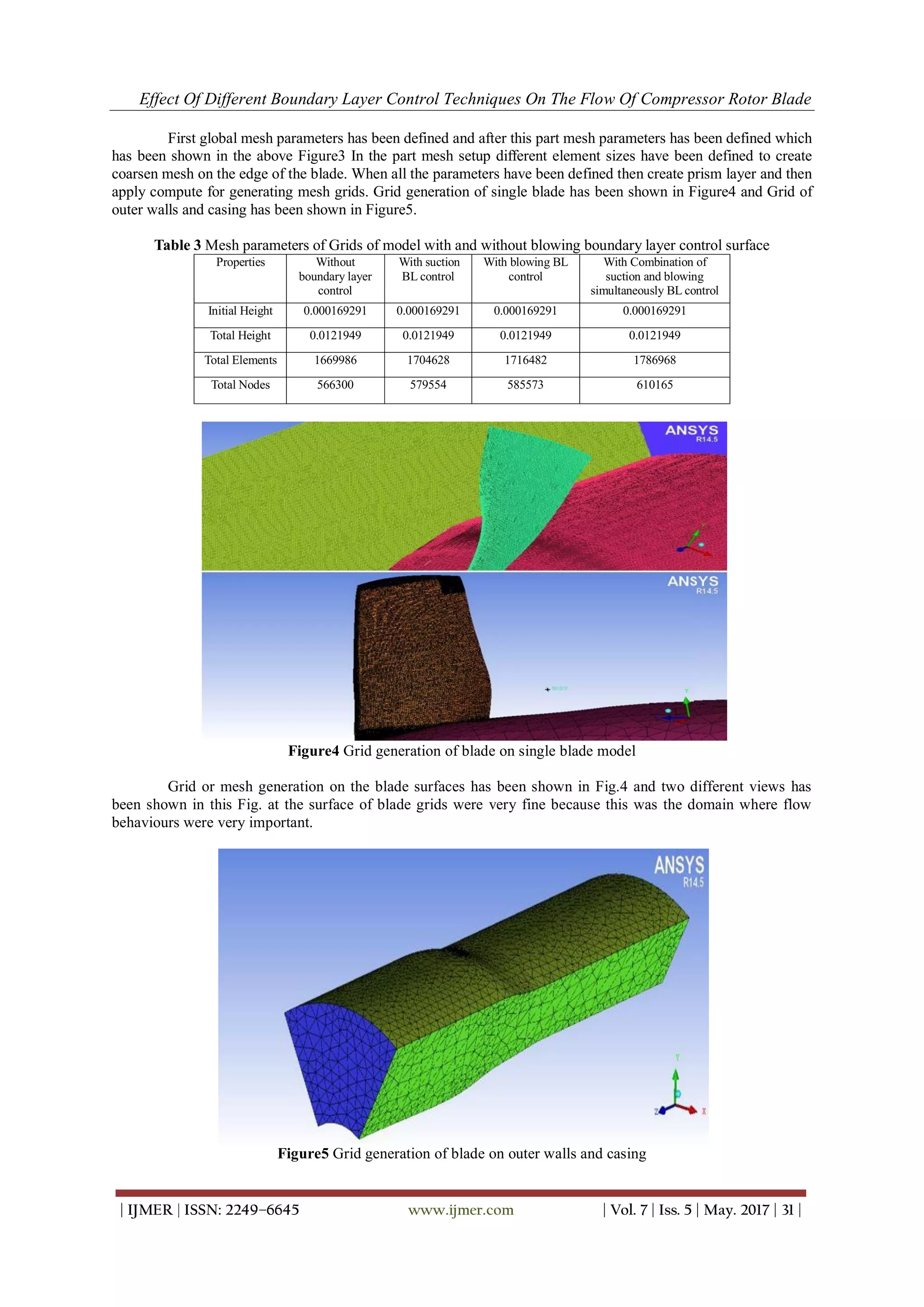
![Effect Of Different Boundary Layer Control Techniques On The Flow Of Compressor Rotor Blade
| IJMER | ISSN: 2249–6645 www.ijmer.com | Vol. 7 | Iss. 5 | May. 2017 | 32 |
Grids formation on the geometry other than blade surface has been shown in the Figure5 and grids of these outer
walls and casings were not very fine because flow behaviour around these surfaces were out of our interest.
3.2.2Grid generation with boundary layer control surface
In the first method one new suction surface with suction hole have been employed in the blade
geometry and while creating parts one new part named as suction layer was created and in the blowing method
blowing surface with hole have been created and prism layer has been employed for both cases. All other steps
were similar to the previous section. In last method this geometry has two control surfaces and two holes. One
was suction surface and other was blowing surface and one was suction hole and other was blowing hole. In the
part creation method these surfaces were also assigned a name and prism layer were calculated for both suction
and blowing surface. Prism layers were applied to these surfaces because we want finer mesh on these surfaces
also and remaining steps to develop grids were similar to previous case.
Figure6 Grid generation of blade model with control surfaces
Grid generation of control surfaces for all three methods has been shown in Fig.6 and on the suction and
blowing surface grids were very fine because we have more interest on the flow behaviour on these surfaces.
3.3 Boundary conditions for computational simulation
Computational Fluid Dynamics has been used to solve the model associated with the fluid flow by
applying numerical methods. There were many CFD software’s like ANSYS- (GAMBIT, FLUENT and CFX
etc.), OPEN FOAM, Gerrish Flow solver etc. available today for computational simulation and analysis. Among
all these software’s ANSYS CFX was high performance CFD tool which delivers accurate and reliable solutions
therefore ANSYS CFX has been used in our study. This software has three tools to do computational simulation
and analysis and they were CFX-pre-processor, CFX solver manager and CFX-post processor.
3.3.1CFX pre-processor
This part of CFD tool worked as pre-processor for the simulation software. Grid file produced in ICEM
should be imported to the CFX-pre by generating CFX input file of that model. After this open this file from
CFX-pre and then domain should be created in pre-processing software and this problem is defined in turbo
mode. Turbo mode has been used to provide some pre-specified conditions.
3.3.1.1 CFX Pre setup for model without boundary layer control surfaces
The settings for CFX- Pre used are based on the units of the mesh imported.
The parameters for the mesh units in mm are:-
Basic Settings
Machine Type : Axial Compressor
Rotation Axis : z
Component type
Type : Rotating
Value -16043 [RPM]](https://image.slidesharecdn.com/e7522738-170718061044/75/Effect-of-Different-Boundary-Layer-Control-Techniques-on-the-Flow-of-Compressor-Rotor-Blade-6-2048.jpg)
![Effect Of Different Boundary Layer Control Techniques On The Flow Of Compressor Rotor Blade
| IJMER | ISSN: 2249–6645 www.ijmer.com | Vol. 7 | Iss. 5 | May. 2017 | 33 |
Tip clearance at shroud : yes
Fluid :-- Air Ideal Gas
Analysis Type : -- Steady State
Model data :
Reference Pressure :- 0 (Zero) Pa
Heat Transfer :- Total Energy
Turbulence :- Shear stress Transport
Wall Functions :- Automatic and compressible high speed heat transfer model
Inflow/Outflow boundary templates: P-total inlet P-static outlet
Inflow Boundary condition:
Mass and Momentum :- Static Frame Total Pressure
Relative Pressure ( P- Total) :- 101325 Pa
Flow direction :- Normal to the boundary
Static Frame Total temperature :- 288.2 K
Outlet Boundary condition:
Mass and Momentum :- Static Pressure and mention pressure as 114500 Pa
Solver Parameter :
Advection Scheme :- High Resolution
Time Scale Control :- Auto Timescale
Length Scale :- Conservative
Maximum Timescale :- 0.000001
Convergence Residual Criteria:- MAX Type and Target as 0.00001
The parameters for the mesh units in cm are:-
Basic Settings
Machine Type : Axial Compressor
Rotation Axis : z
Component type
Type : Rotating
Value -3600 [RPM]
Tip clearance at shroud : yes
Fluid :-- Air Ideal Gas
Analysis Type : -- Steady State
Model data :
Reference Pressure :- 0 (Zero) Pa
Heat Transfer :- Total Energy
Turbulence :- Shear stress Transport
Wall Functions :- Automatic and compressible high speed heat transfer model
Inflow/Outflow boundary templates: P-total inlet P-static outlet
Inflow Boundary condition:
Mass and Momentum :- Static Frame Total Pressure
Relative Pressure ( P- Total) :- 101325 Pa
Flow direction :- Normal to the boundary
Static Frame Total temperature :- 288.2 K
Outlet Boundary condition:
Mass and Momentum :- Static Pressure and mention pressure as 114500 Pa
Solver Parameter :
Advection Scheme :- High Resolution
Time Scale Control :- Auto Timescale
Length Scale :- Conservative
Maximum Timescale :- 0.000001
Convergence Residual Criteria:- MAX Type and Target as 0.00001
3.3.1.2 CFX Pre setup for model with boundary layer control surfaces
The suction boundary layer was applied as outlet and the two conditions were put up on it according to
the two mass flow rates selected. The mass flow rates for the suction boundary layer were put up according to
the literature review which states that the aspiration of 2% mass flow rate was most effective in controlling the
boundary layer separation. So mass flow rates of 1Kg/s and 1.5Kg/s were used. The blowing boundary layer](https://image.slidesharecdn.com/e7522738-170718061044/75/Effect-of-Different-Boundary-Layer-Control-Techniques-on-the-Flow-of-Compressor-Rotor-Blade-7-2048.jpg)
![Effect Of Different Boundary Layer Control Techniques On The Flow Of Compressor Rotor Blade
| IJMER | ISSN: 2249–6645 www.ijmer.com | Vol. 7 | Iss. 5 | May. 2017 | 34 |
was applied as outlet and the two conditions were put up on it according to the two mass flow rates selected.
Mass flow rates of 1 kg/s and 1.5 kg/s has been used in this case.
The parameters for the problem applied are:-
Basic Settings
Machine Type : Axial Compressor
Rotation Axis : z
Component type
Type : Rotating
Value -16043 [RPM]
Tip clearance at shroud : yes
Fluid :-- Air Ideal Gas
Analysis Type : -- Steady State
Model data :
Reference Pressure :- 0 (Zero) Pa
Heat Transfer :- Total Energy
Turbulence :- Shear stress Transport
Wall Functions :- Automatic and compressible high speed heat transfer model
Inflow/Outflow boundary templates: P-total inlet P-static outlet
Inflow Boundary condition:
Mass and Momentum :- Static Frame Total Pressure
Relative Pressure ( P- Total) :- 101325 Pa
Flow direction :- Normal to the boundary
Static Frame Total temperature :- 288.2 K
Outlet Boundary condition:
Mass and Momentum :- Static Pressure and mention pressure as 114500 Pa
Suction:
Mass and Momentum :- Outlet and mass flow rate of 1Kg/s or 1.5 Kg/s
Blowing:
Mass and Momentum :- Inlet and mass flow rate of 1 Kg/s or 1.5 Kg/s
Solver Parameter :
Advection Scheme :- High Resolution
Time Scale Control :- Auto Timescale
Length Scale :- Conservative
Maximum Timescale :- 0.000001
Convergence Residual Criteria:- MAX Type and Target as 0.00001
3.3.2 CFX solver manager
Output file generated in previous file was the input file for this part and for computational simulation
graphical interface method has been used by this tool. In our study Double precision has been used because this
would give results with more accuracy but when this solver has been applied to execute the file this would take
double computational memory.
3.3.3 CFX post-processor
The result or output file of CFX solver manager worked as input file for this tool and first that output
file has been loaded in to this tool. When the results were initialized thermodynamic properties can also be
extracted from optimization process therefore expression of isentropic efficiency and pressure ratio has been
also created in expression tab of CFD-Post.
IV. RESULTS AND DISCUSSION
There were two defined models for analysis and this analysis has been done in CFX post-processor.
First model without any boundary layer control surfaces has been analysed and then model with combination of
suction and blowing boundary layer control surfaces. Three dimensional simulations have been done by using
simulation software ANSYS CFX. In post processing results have been analysed in the form of velocity vectors.
Velocity vectors have been checked not at various section of span but also at two models with changed length
units and rpm.](https://image.slidesharecdn.com/e7522738-170718061044/75/Effect-of-Different-Boundary-Layer-Control-Techniques-on-the-Flow-of-Compressor-Rotor-Blade-8-2048.jpg)
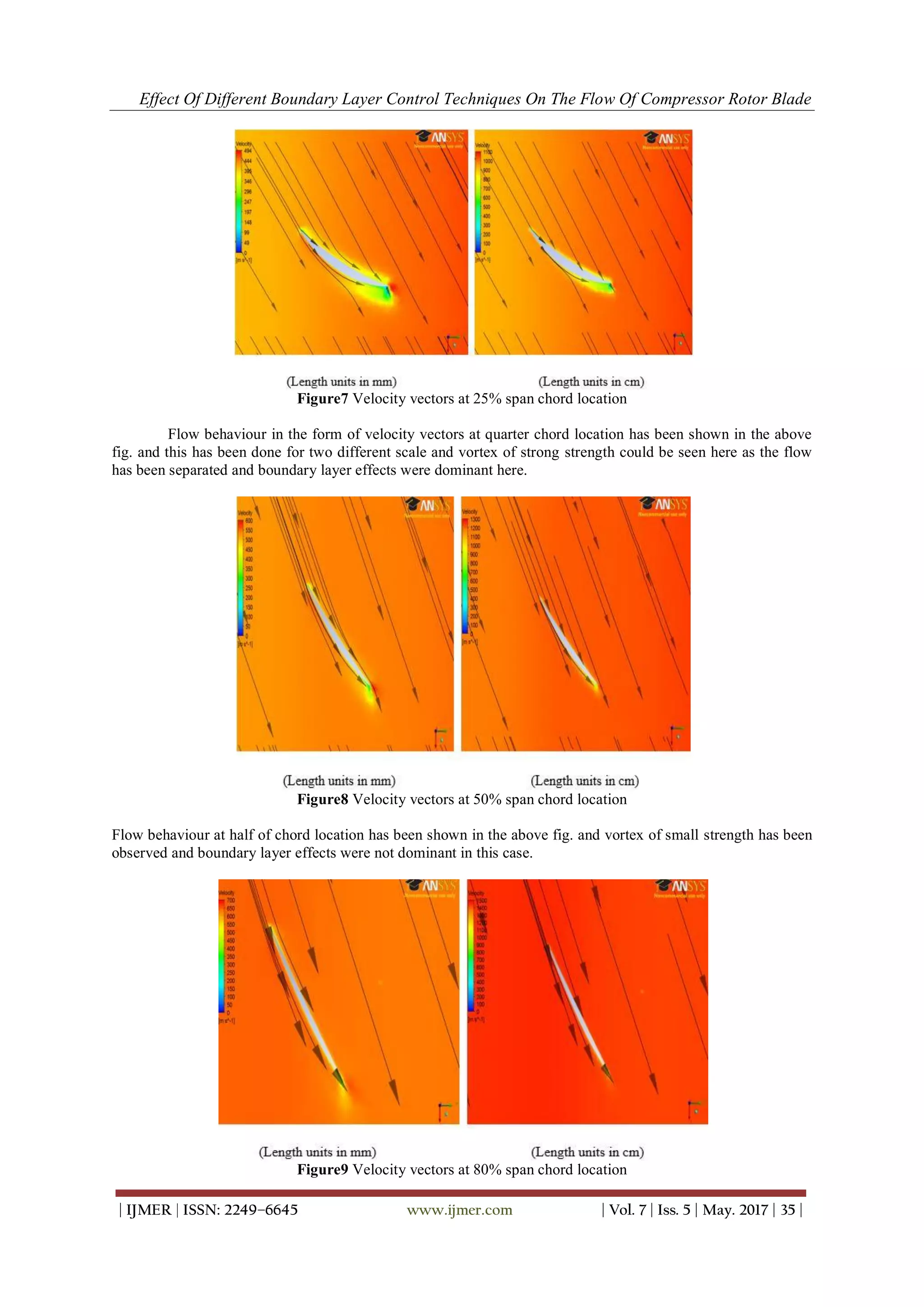
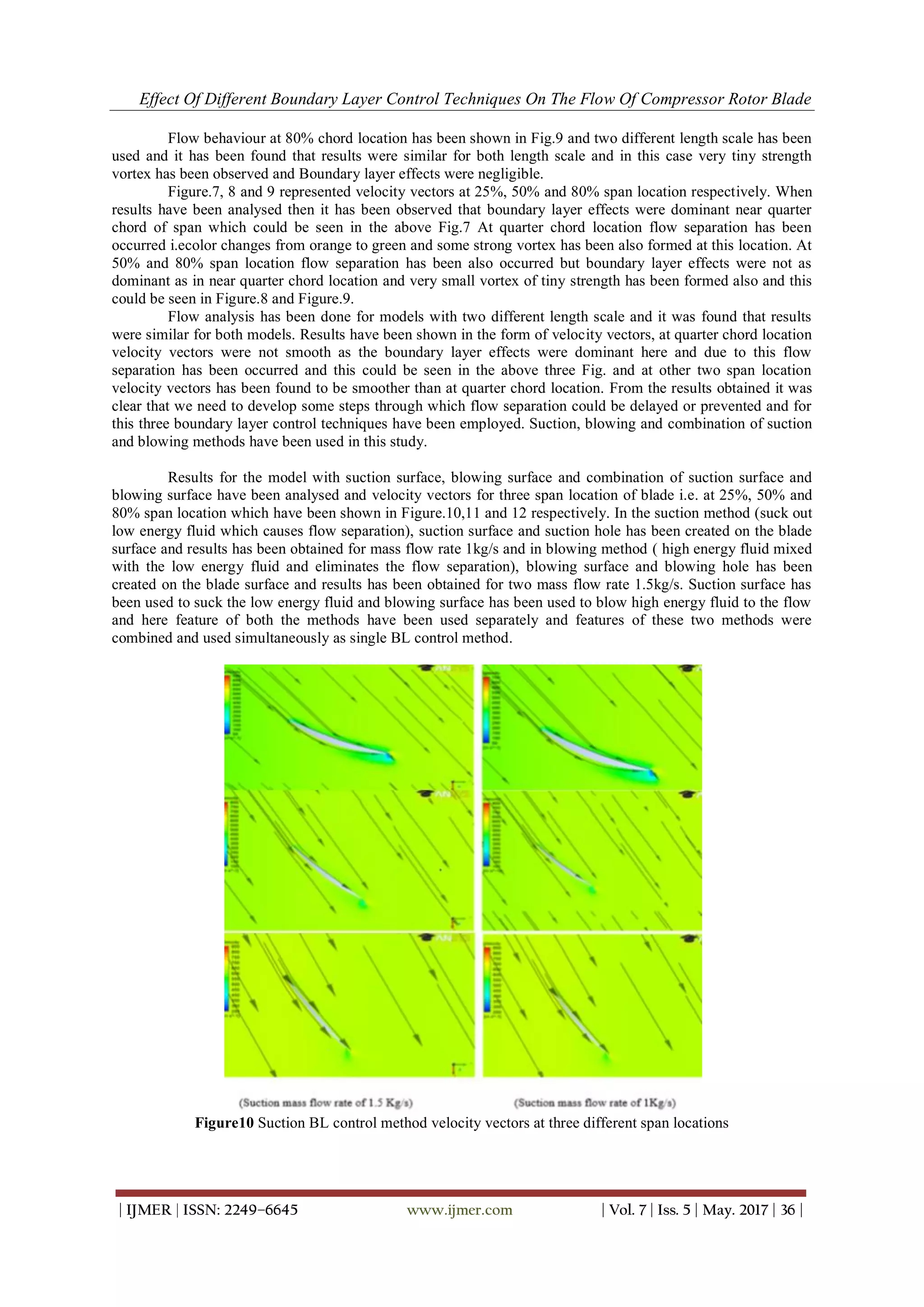
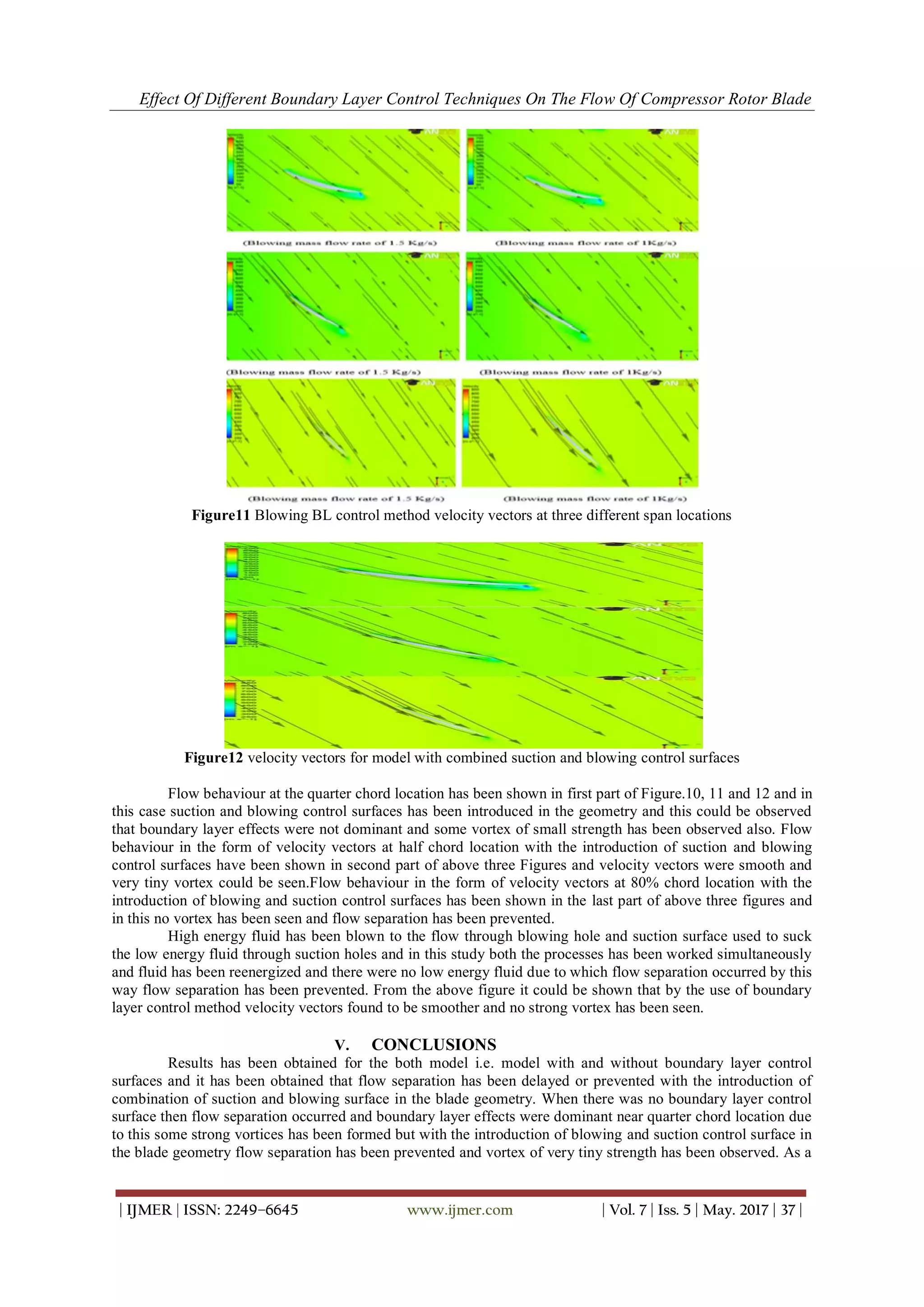
![Effect Of Different Boundary Layer Control Techniques On The Flow Of Compressor Rotor Blade
| IJMER | ISSN: 2249–6645 www.ijmer.com | Vol. 7 | Iss. 5 | May. 2017 | 38 |
result pressure ratio has been observed as 1.652, 1.690 and 1.724and increment in pressure ratio has been found
to be 0.052, 0.09 and 0.11 for suction, blowing and combination of suction and blowing methods respectively.
ACKNOWLEDGEMENTS
Authors would like to thank university for providing computational facilities and colleagues for their
continuous support. Special thanks to co-author Late Twisha Patel for her support. I heartily pay my gratitude to
my colleagues Late Twisha Patel as she had been constantly helping me in it. Without their co-operation and
support, working on this paper would have been very difficult.
REFERENCES
[1]. Kumar Navneet, “Flow modification over rotor blade with suction boundary layer control technique”, International
Journal of Engineering Research and Application,Vol.6, no.6,pp 1-5, 2016.
[2]. Kumar N., “Modification of rotor blade flow with blowing boundary layer control technique”, International
Journal of Multidisciplinary Educational Research, vol.5, no.7, pp209-228, 2016.
[3]. Kumar Navneet and Patel Twisha, “Flow Modification over Rotor Blade with Boundary Layer Control
Technique”, International Journal of Innovative Research in Science, Engineering and Technology, vol.5, Issue8,
pp 15211-23, 2016.
[4]. Y. Ito, T. Watanabe and T. Himeno, “Effect of Endwall Countering on Flow Instability of Transonic Compressor”,
International Journal of Gas Turbine, Propulsion and Power system, Vol.2, no.1, 2008.
[5]. N. Ananthkrishnan, U. G. Vaidya and V. W. Walimbe, “Global stability and control analysis of axial compressor
stall and surge phenomena using bifurcation method”, Institution of mechanical Engineers J Power and Energy,
vol.217, no.1, 2001.
[6]. Abate, Giada,“Aerodynamic optimization of transonic axial compressor rotor”, Journal of Propulsion and Power,
vol.54, no.4, pp.41-55, 2003.
[7]. Benini and Ernesto,“Three dimensional multi objective design aerodynamic optimization of transonic compressor
rotor”,International Journal of Gas Turbine, Propulsion and Power System, vol.54, no.5, 2004.
[8]. Brian Joseph Schuler, “Experimental Investigation of an aspirated fan stage, doctoral diss.”, Massachusetts
Institute of Technology, Cambridge, MA, 2001.
[9]. A. Sarkar, B. Singla and N. Kumar, “CFD analysis of Rotor 67 Blades, University of Petroleum and Energy
Studies”, Dehradun, India pp.23-52, 2015.
[10]. Tangler, James L. The evolution of rotor and blade design.National Renewable Energy Laboratory, 2000.
[11]. Lachmann, Gustav Victor, ed. Boundary layer and flow control: its principles and application. Elsevier, 2014.
[12]. Reijnen, Duncan Peter. Experimental study of boundary layer suction in a transonic compressor.Diss.
Massachusetts Institute of Technology, 1997.
[13]. Tindell, Runyon H. "Blown boundary layer control system for a jet aircraft." U.S. Patent No. 5,447,283. 5 Sep.
1995.
[14]. Macaulay, Jack R., et al. "Aircraft boundary-layer control system." U.S. Patent No. 2,920,844. 12 Jan. 1960.](https://image.slidesharecdn.com/e7522738-170718061044/75/Effect-of-Different-Boundary-Layer-Control-Techniques-on-the-Flow-of-Compressor-Rotor-Blade-12-2048.jpg)